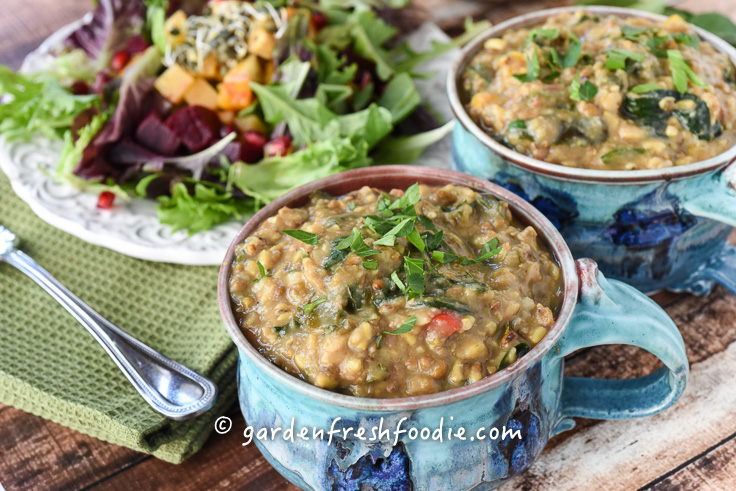 Did you hear how EVERYONE should be eating more pulses (that’s another name for legumes)?! It’s the year of the pulse so move them into your diet! They’re great for you and the planet! Kitchari fits the bill for being great for the earth and your body! Kitchari, pronounced kit-char-ee, is the Indian version of chicken soup. It’s filled with nutritious, warming ingredients, making it perfect to comfort you when you’re feeling like you want your mommy or a big blanket. As Hippocrates stated “Let food be thy medicine and thy medicine be thy food”. Kitchari’s primary components are rice, mung beans, and spices. Feel free to mess round with other veggies that are in-season to make different versions of this stew. When you make this, your whole house will smell delicious. It makes a great sized portion so that you can have left overs throughout the week. Side note, it does thicken a lot as it sits. No worries-simply add some water when you’re reheating it to the texture you want, less if you want it as a stew, more if you want it more soup like. I like it thicker, but to each their own!
Did you hear how EVERYONE should be eating more pulses (that’s another name for legumes)?! It’s the year of the pulse so move them into your diet! They’re great for you and the planet! Kitchari fits the bill for being great for the earth and your body! Kitchari, pronounced kit-char-ee, is the Indian version of chicken soup. It’s filled with nutritious, warming ingredients, making it perfect to comfort you when you’re feeling like you want your mommy or a big blanket. As Hippocrates stated “Let food be thy medicine and thy medicine be thy food”. Kitchari’s primary components are rice, mung beans, and spices. Feel free to mess round with other veggies that are in-season to make different versions of this stew. When you make this, your whole house will smell delicious. It makes a great sized portion so that you can have left overs throughout the week. Side note, it does thicken a lot as it sits. No worries-simply add some water when you’re reheating it to the texture you want, less if you want it as a stew, more if you want it more soup like. I like it thicker, but to each their own!
You may not be familiar with some of the ingredients in this recipe, but don’t let that scare you! Mung beans are a staple in Indian cooking. They are sold whole, as used in this recipe, or split, like a pea (FYI-you can use split mung for this recipe too). They are great for sprouting, and are often sold in super markets as “bean sprouts”, you’ll see them as long white sprouts. This is past their nutritional benefit. To learn more about how to sprout them, click here for my directions.  Mung beans, like all legumes, are packed with magnesium, potassium, fiber, and plant-based protein. You can find them in the Indian section of your grocery store, at an Indian market, or in bulk at your local food co-op. Like wise, you can find curry leaves at your Indian market. Curry leaves, add a beautiful flavor, and are not the leaves that create curry. Curry leaves are more like a bay leaf, and can be found at local Indian markets. Buy them fresh. They store very well in your fridge, wrapped in a damp paper towel for weeks, and make great additions to soups, stews, and when cooking a simple rice. If you can’t find them, you can omit them. For some other recipes using curry leaves, check out my Late Fall Red Lentil Soup, Indian Cauliflower Rice Bowl, Tomato Curry Soup, or Tofu Curry.
Mung beans, like all legumes, are packed with magnesium, potassium, fiber, and plant-based protein. You can find them in the Indian section of your grocery store, at an Indian market, or in bulk at your local food co-op. Like wise, you can find curry leaves at your Indian market. Curry leaves, add a beautiful flavor, and are not the leaves that create curry. Curry leaves are more like a bay leaf, and can be found at local Indian markets. Buy them fresh. They store very well in your fridge, wrapped in a damp paper towel for weeks, and make great additions to soups, stews, and when cooking a simple rice. If you can’t find them, you can omit them. For some other recipes using curry leaves, check out my Late Fall Red Lentil Soup, Indian Cauliflower Rice Bowl, Tomato Curry Soup, or Tofu Curry.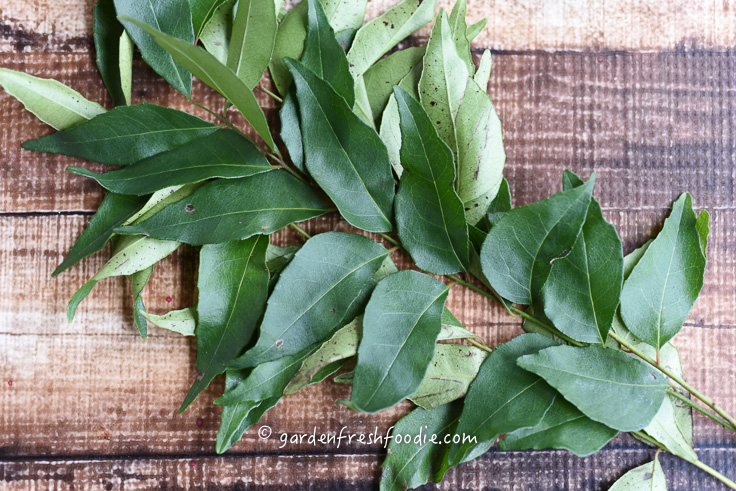
I often add mushrooms, which provide Vitamin D and B-12, one of the few plant-based sources. There’s garlic and ginger in this stew, both of which boost immunity against colds and flu, and aid in digestion. Peppers pack in the vitamin C-immune boosting aspect as well (did you know peppers have almost 4x’s the Vitamin C than oranges do?!). Kale adds in protein and calcium, as well as Vitamin K, iron, and Vitamin C. So many good things in this recipe!!!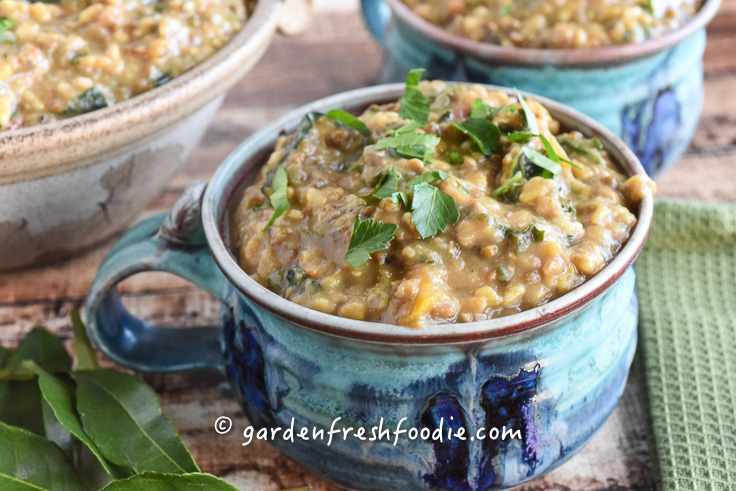
By using a pressure cooker to make this, this dish is done in about 30 minutes, start to finish. If using traditional methods, it will take a little longer, but you’ll have a little more control over thickness.
I served this kitchari with a salad topped with my sage roasted winter veggies to round out the meal. When eaten like this-you’ll get every color and nutrient!! Plus-no oils or added fats! The perfect meal to boost health and wellness!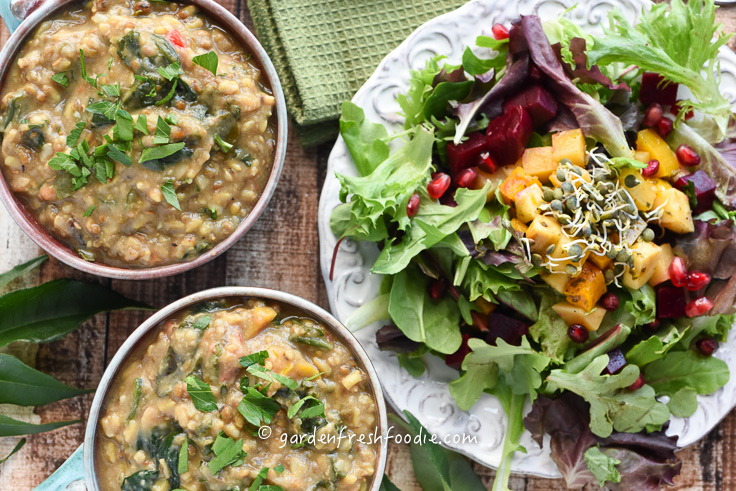
Ingredients:
- 1 1/2 cups mung beans (soaked for 4 hours)
- 1 cup brown rice
- 1 1/4 cup small diced peppers
- 2 tbsp minced jalapeño, about 1 pepper
- 2 cup minced onion
- 4 cups medium diced eggplant (other ideas are zucchini, cauliflower, or a combo of these)
- 2 cups of mushrooms (if desired)
- 2 cups diced tomato or 1 15 oz can
- 1 3/4 tsp kosher salt
- 1 tsp turmeric
- 2 tsp cumin seed (if you don’t have seed, can use ground)
- 1 tsp fenugreek seed
- 2 tbsp minced fresh ginger (we keep ours in the freezer to increase its longevity)
- 1 1/2 tbsp minced garlic
- 3/4 tsp chili flake (to taste)
- 2 curry leaf stalks or 2 bay leaves
- *optional addition, 3 cups chopped mushrooms, omit if you’re not a fan
- 8 cups water
- 5 cups chopped kale
- Additional salt/pepper to taste
- Parsley for serving
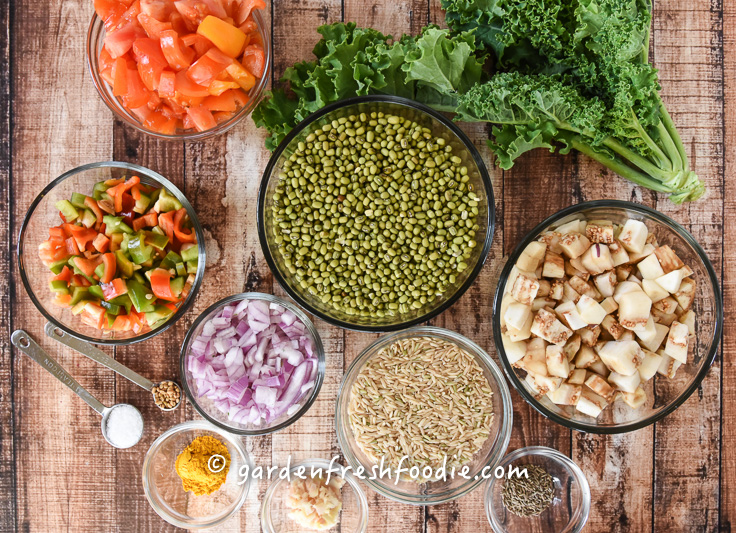
Instructions:
- Place all ingredients into a pressure cooker (preferred), or good sized pot, except kale.
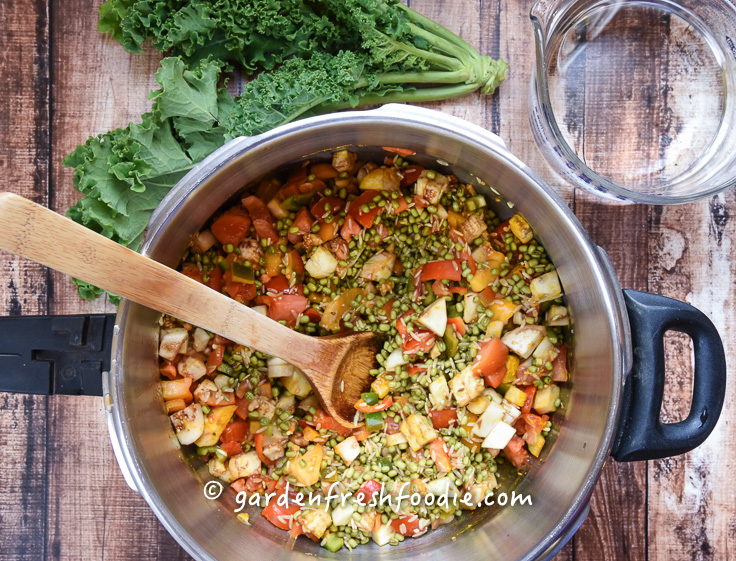
- Pressure cooker method: Bring to pressure, or boil. If using a pressure cooker, bring to pressure and turn down to low. Set timer for 15 minutes. Turn off stove, and let pressure drop. Let kitchari sit for another 10 minutes or so, for additional water to absorb
- Traditional cooking method: bring mixture to boil, reduce to simmer, and cook until rice and mung beans are no longer hard, about 45 minutes.
- Stir in kale, and season with additional salt/pepper if desired. Top with fresh parsley and serve with a salad.
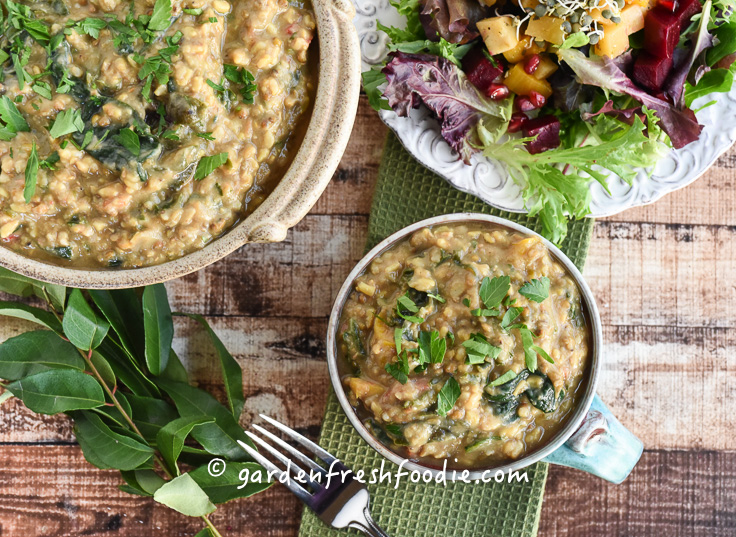
Nutritional Benefits:
- Oil, cholesterol, and fat free-great for heart health and diabetes
- Vegan and gluten free-helps to fight inflammation in the body
- Great source of fiber, 8.4 g-helps to lower cholesterol, blood pressure, boost digestive health, and increase satiety. It also helps to regulate blood sugar and to prevent blood sugar spikes
- Great source of plant-based protein, 11g; good for healing and repairing tissues
- Great source of Vitamin C, 141% DV, immune boosting antioxidant, helps fight inflammation
- Great source of potassium, 825 mg, important for nervous system and kidney function, as well as regulating blood pressure and heath rate
- Great source of Vitamin A, 116% Vitamin A, important for hair, nail, bone, and dental health, as well as blood pressure regulation and decreasing inflammation
- Great source of plant-based iron, 18% iron, important for oxygenation of blood
- Great source of plant-based calcium, which is better absorbed by the body than animal based sources, 10% DV, important for bone and dental strength, as well as nervous system function.
- 1½ cups mung beans (soaked for 4 hours)
- 1 cup brown rice
- 1¼ cup small diced peppers
- 2 tbsp minced jalapeño, about 1 pepper
- 2 cup minced onion
- 4 cups medium diced eggplant(other ideas are zucchini, cauliflower, or a combo of these)
- 2 cups of mushrooms (if desired)
- 2 cups diced tomato or 1 15 oz can
- 1¾ tsp kosher salt
- 1 tsp turmeric
- 2 tsp cumin seed (if you don't have seed, can use ground)
- 1 tsp fenugreek seed
- 2 tbsp minced fresh ginger (we keep ours in the freezer to increase its longevity)
- 1½ tbsp minced garlic
- ¾ tsp chili flake (to taste)
- 2 curry leaf stalks or 2 bay leaves
- *optional addition, 3 cups chopped mushrooms, omit if you're not a fan
- 8 cups water
- 5 cups chopped kale
- Additional salt/pepper to taste
- Parsley for serving
- Place all ingredients into a pressure cooker (preferred), or good sized pot, except kale.
- Pressure cooker method: Bring to pressure, or boil. If using a pressure cooker, bring to pressure and turn down to low. Set timer for 15 minutes. Turn off stove, and let pressure drop. Let kitchari sit for another 10 minutes or so, for additional water to absorb
- Traditional cooking method: bring mixture to boil, reduce to simmer, and cook until rice and mung beans are no longer hard, about 45 minutes.
- Stir in kale, and season with additional salt/pepper if desired. Top with fresh parsley and serve with a salad.
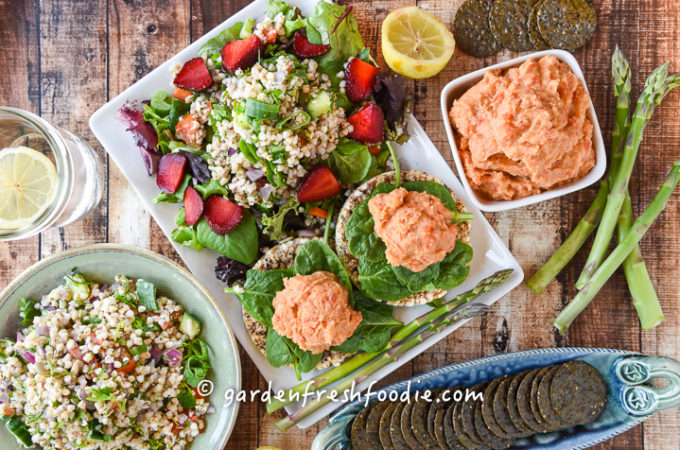
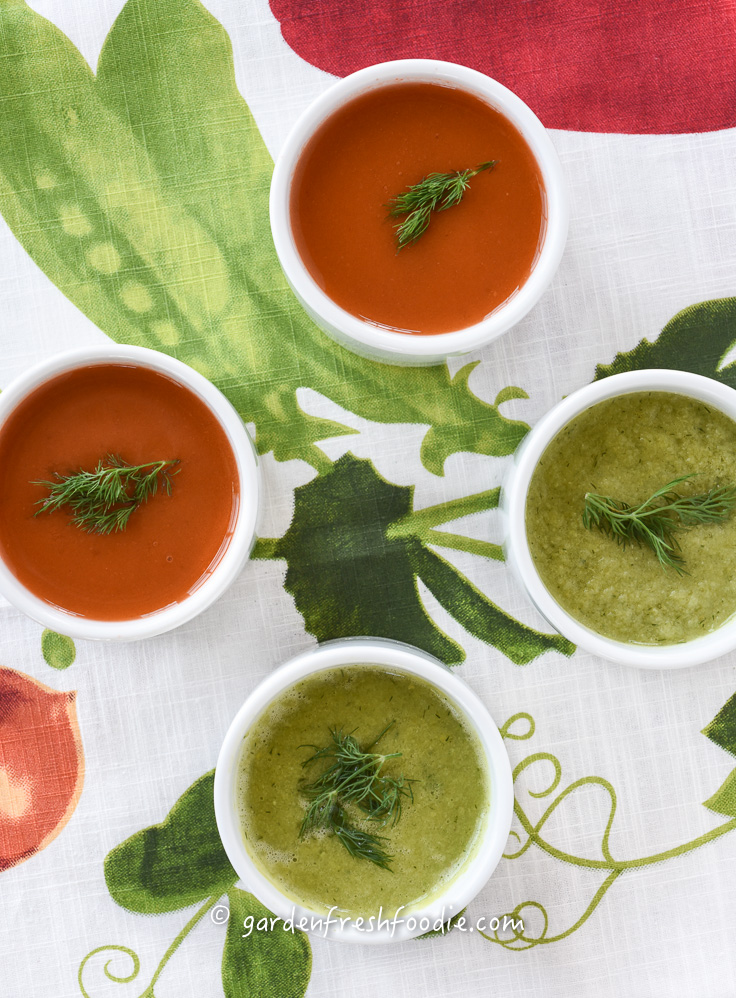
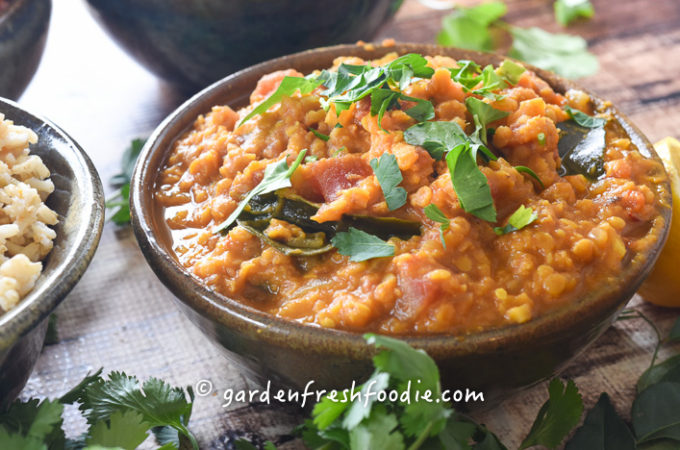
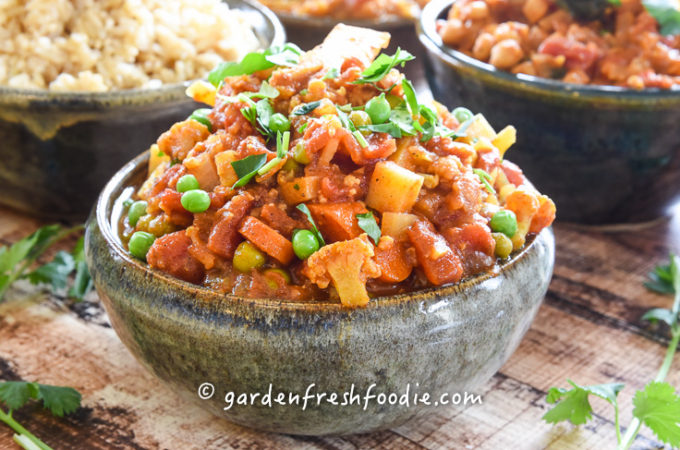
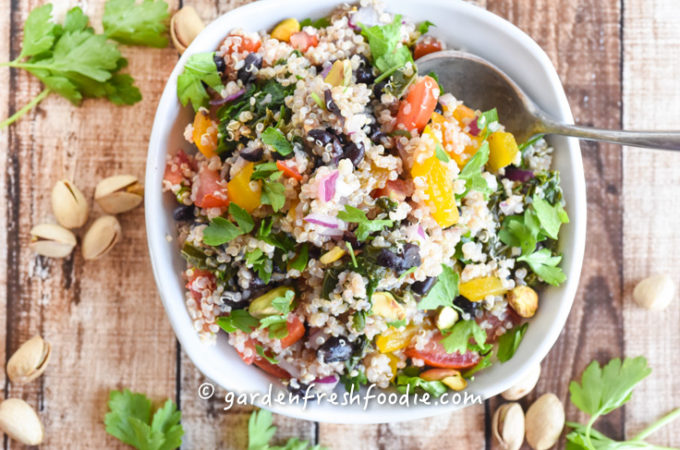
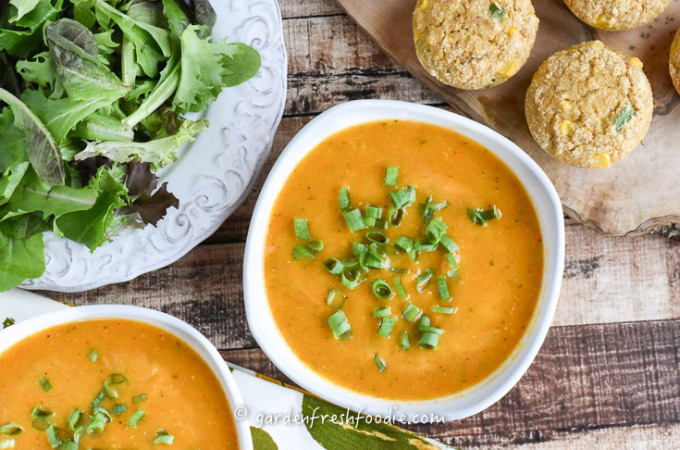
Traditionally khichadi is made with two ingredients. Simple khichadi: Rice + toor dhal or Rice + Split mung beans.
Then there are 100s of versions of khichdi depending on which part of india you are from.
There is ‘vaghareli khichdi’ from gujarat.
There is bisi bhele bhat from South india.
Thank you. I hope you enjoy my version! Let me know!